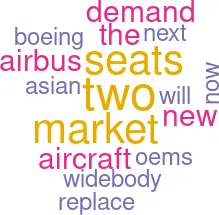OEMs’
Asian century
October 2018


The two big OEMs used the appropriate venue of AAPA’s Assembly of Presidents, held in South Korea this October, to re-emphasise the importance of the Asian market, which is now expected to account for well over 40% of future aircraft demand.
Boeing predicts that over the next 20 years Asia will require 16,930 aircraft worth $2.7tn, two thirds of which will be for expansion, just one third for replacement. Airbus more of less agrees: 15,900 units valued at $2.4tn. To put the trillions of aircraft investment into some sort of perspective, the current GDP of China is about $8.4tn, that of Japan, around $6tn.
Boeing made an interesting observation on the accuracy of its previous forecasts: the narrowbody market had been significantly underestimated; the widebody market was correctly forecast; but demand for regional jets and ultra-widebodies had been seriously overestimated.
Airbus, not coincidentally, has a major commitment to the latter two sectors in the form of the A220, formerly known as the Bombardier CSeries, and the A380. Despite recent disappointments, Airbus still reckons that there is potential for 480 ultra-widebodies in the Asian market alone over the next 20 years.
It is perhaps not surprising that narrowbody orders have been underestimated as investment in these types is driven by new LCCs whose raison d’être is to create new markets and generate unexpected demand for aircraft. Without legacy commitments, they are able to force the two OEMs into fierce price and condition battles between the 737 and A320s families (now MAXs vs neos). What is all-important for the LCCs is achieving the lowest possible unit capital and operating costs, and that implies bulk ordering. Boeing’s NMA (New Midsize Airplane), a 757/767 replacement, is the potential disrupter in this market.
Widebody demand should be more predictable because it comes from network carriers operating largely within the constraints of complicated network planning, infrastructure constraints and bilateral regulation. However, such is the dynamism of the Chinese aviation market, that assumption may no longer be valid.
What is fascinating is the range of widebodies now being offered by the two OEMs.
Airbus is selling two variants of the A330, the -800 and -900 with 250-350 seats, claiming to have the lowest capital costs in the widebody sector. The A350 XWB also comes in two variants, the -900 and -1000 with 320-370 seats. SIA has launched Singapore to New York with the A350-ULR (but with only 161 seats).
Boeing offers the 787 in three sizes: the -8 (~240 seats), -9 (290 seats), and -10 (330 seats). The -8 is designed to replace the 767 or A330-200, the -9 to replace the 767-200ER or A330/340 and the -10 to replace the 777-200/300 or A330/340. The larger capacity 777X, featuring folding wing tips, will be flight tested next year and should be ready for service in 2020.
FLEET GROWTH
Source: Boeing
TRAFFIC/FLEET GROWTH
Source: Airline Monitor
Source: Airline Monitor